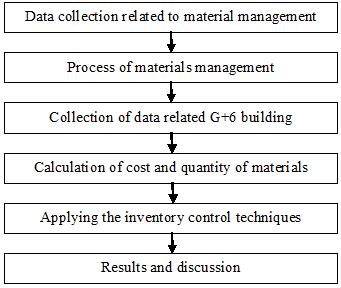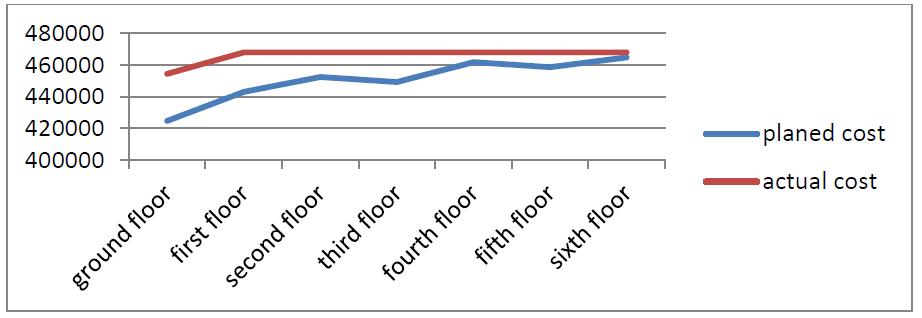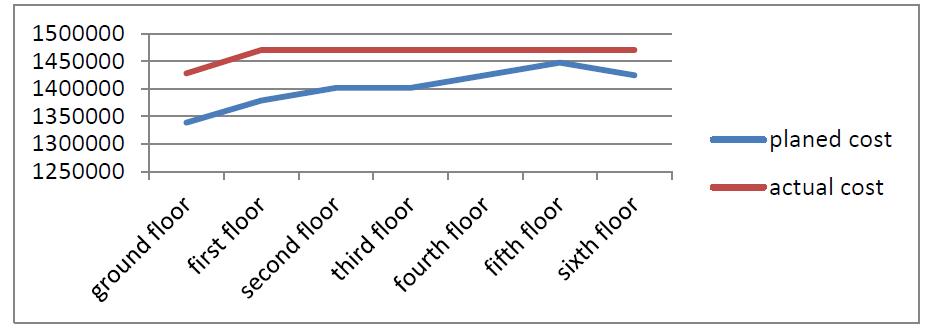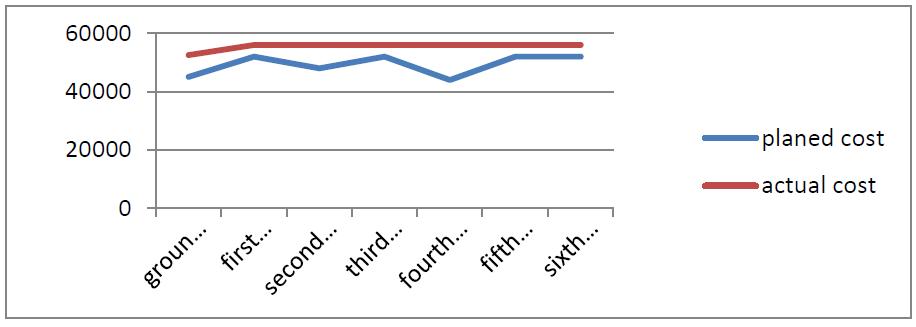International Journal of Engineering Research and Reviews ISSN 2348-697X (Online) Vol. 10, Issue 2, pp: (35-42), Month: April - June 2022, Available at: www.researchpublish.com
A CRITICAL ANALYSIS OF MATERIAL MANAGEMENT TECHNIQUES IN CONSTRUCTION PROJECT
HARSH A. RAJYAGURU1Assistant Professor
Institute of Technology, Mehsana, Gujarat, India
DOI: https://doi.org/ 10.5281/zenodo.6623615
Published Date: 08-June-2022
Abstract: This In construction sector, material management plays major role for effective completion of the project. The cost of project increases when the planning, material identification system is poor. Shortage and deficiency in storage of material will cause losses in labour productivity. To maintain the effective management, to achieve the timely supply of materials and equipment and to reduce the cost of projects, a well-planned material management program is required. This improves planning, higher labour productivity, proper schedules and lower project costs. This paper explains about the techniques for material management for construction project by using S-Curve, ABC Analysis for clear understanding the management of four important construction materials. By implementing these techniques, we have found an optimized way to reduce the cost of the project. Using Scurve technique, the variation in planned cost and actual cost is assessed. Quantity of materials procured for the project should be determined by the using A-B-C analysis.
Keywords: Material management, Procurement, Inventory Control Techniques, A-B-C analysis, S-curve.
I. INTRODUCTION
Materials is main role in construction project and also main cost component in construction sector, materials can take 50% and above of the total cost of project. The main aim of material management to reduce the cost of project by using different techniques, Material management is defined as "the process to provide right material at right place at right time in best quantity so as to minimize the cost of project". the goal of material management is to ensure that construction materials are available at right quality of material and quantity of material are appropriately selected, purchased, delivered and handle on site in a timely manner and at reasonable cost. Material management place a major role in project management, to minimize the procuring, cost material should be procured within the time; delay in the material procuring leads to increase of construction cost efficient management of material can help to save the project cost. Timely flow of material is a crucial factor of material management, if u procures more material before by dumping in a site it leads to stolen of material, damage of material, if and every material has its own properties and performance of material should be compared. This performance may defer from system to system, the material should be used the efficiently by maintain them by storing in a perfect place without occurring any damage to them. The flow of material should be ordered and received and stored until they are use adequately. Basically, material management is associated with receiving, procuring storage, identification and planning the increases the population as well as economic growth. The construction activities as been increasing rapidly, so the amount of construction waste has been the waste material can also be reutilized in construction. Different material taken from the waste can be used for various purpose those waste generation thought the construction storages needed to be identification and quantified to decrease the wastage.
International Journal of Engineering Research and Reviews ISSN 2348-697X (Online) Vol. 10, Issue 2, pp: (35-42), Month: April - June 2022, Available at: www.researchpublish.com
A. Process of material management
Planning: Material management first step is planning in that case to measuring, ordering and scheduling, material planning is most important process to increase the productivity, profit and assisting the time to complete the construction project. In that construction the material process not implemented the total project will be damaged and the project will not complete with in the time. If maintain the proper planning in material to decrease the total project cost and the material waste also decreases.
Purchasing: Purchasing of material is involved in maintaining control over the ordering, in every construction project purchasing and receiving functions are important, purchasing department is one of main responsible part to ordering the best quality and right price at right time, in construction project purchasing department is procedure applies to purchase of all material related to construction, services, supplies, tools, equipment and equipment rental for all development.
Construction purchasing procedure actives are mainly 1) Purchasing over review
Logistics: logistics means total handling of materials that means procuring, maintenance and transportation. It deles the entire thing of materials like if product starting to construct and endpoint of the material. Logistics mainly define that stresses movement of the materials and it involves the planning, implementation and controlling the movement and storage of all things from raw materials to complete the product to required specifications.
Handling: Handling of materials means to maintains the perfect order to supply the materials for their movement and location, in material handling to give the rating to materials based on quality and it should be considered when designing a material handling system, to supply the effective operation of manpower, increase the output and advance to the system for more flexible.
Stock And Waste Control: Stock control means to maintain proper technique to be cover and supply of all materials when they are required, it include the raw materials, processed materials, arrange all works, to maintained the materials and spares. It’s important part in materials management to supplies the materials at required time to time, at the time of constriction site work the waste can produced to maintain proper planning to the materials to control the materials waste and it help to increases of profits of the companies.
II. OBJECTIVES
To compare the planned and actual material consumption and also to find out the problems facing in planning, purchasing, procurement and regarding the material management
Find out the analysis of planned and actual cost of construction material
Applying the inventory control technique to minimize the cost of project
III. METHODOLOGY
Study first collected the materials like literature review and latest published papers related to material management, in many literature reviews ABC analysis, S curve analysis are commonly used for material management, in most of cases ABC analysis most important.
International Journal of Engineering Research and Reviews ISSN 2348-697X (Online) Vol. 10, Issue 2, pp: (35-42), Month: April - June 2022, Available at: www.researchpublish.com
Fig 1: Step by step process of methodology
A. Description of structure:
In present construction scenario there are lots of changes are happening various techniques are implementing in day-today life of construction. Data collected from a six stored residential project which is undergoing in undavalli which is 10 km far from Mehsana city. As a growing city the infrastructure is also developing in speedy manner. The residential building consists of 6 floors and each floor is having 4 houses. As per the contractor’s estimation it will take 2 years to complete the entire project with a budget of 2crore rupees. The major identified problems in the area is the material shortage due to the over requirement of the materials by the other contractors and because of site conditions the material storage is also a big issue to them.
IV. DATA COLLECTION
TABLE I: TOTAL QUANTITY OF MATERIALS
A. Inventory control techniques
ABC analysis
The ABC analysis is used to identifying material items that has a high impact on overall inventory cost. In this method materials divided into three Groups. A class, B class & C class. A Class material which requires the highest consideration, B Class materials which require medium consideration, and C Class materials which require the least consideration such that the control mechanism be focused on selective class of materials.

International Journal of Engineering Research and Reviews ISSN 2348-697X (Online)
Vol. 10, Issue 2, pp: (35-42), Month: April - June 2022, Available at: www.researchpublish.com
Methodology Adopted for ABC analysis
List the materials items used in the project along with unit cost and quantity.
Compute the Annual Usage Value (AUV) of each material item.
Graph is plotted between cumulative percentages of units and cumulative percentages
of items.
Material quantity in percentage=
B. Percentage of materials for ABC analysis
Material quantity in percentage= (each materials cost /total cost of materials)*100.

Total four material cost =15431660.00/-
“A” class -5% to 10% of the items represent 60% to 70% money value.
“B” class -15% to 20% of the items represent 15% to 20% money value.
“C” class -60% to 70% of the items represents 5% to 10% money value.
“A” class material is cement
“B” class material is sand
“C” class materials are aggregate and bricks
C. S-curve analysis
S curve analysis is an important project management tool. This analysis is carried for comparison between planned and actual cost for material items. S-curve provides at view of project performance in terms of cost and time. Analysis of Scurves permits project management team to essay identify the project growth, slippage, and potential problems that could adversely impact the project if no corrective action is taken.
S curve analysis Cost variance is calculated as difference between Budget costs for work performed (BCWP) and Actual cost for work performed (ACWP). Cost performance is calculated as ratio of Budget cost for work performed to Actual cost for work performed.
D. Planned cost for the G+6 residential building (S curve)
Calculation of cement, sand, aggregate and estimating the cost for ground floor
Cement calculation:
Grade of concrete: M60
Mix proportions 1:1.36:1.74 (1=Cement, 1.36= Sand, 1.74= Aggregate)

Ground floor concrete work= 405(cum)
1 CUM of cement = 551(kgs) Proximately 12 bags of cement
Required cement for ground floor (kgs) = area of ground floor×1cum of cement
= 405×551= 223155(kgs)
International Journal of Engineering Research and Reviews ISSN 2348-697X (Online) Vol. 10, Issue 2, pp: (35-42), Month: April - June 2022, Available at: www.researchpublish.com
Cement bags required for ground floor= 4463 bags for 405(cum).
Cost of cement bag (50 kg) = 320.00/-
Total Cost of the cement bags for 405(cum) = 4463×300= 1428160.00/-
Sand calculation:
Sand (kgs)= (cement(kgs)×1.36)
=223155×1.36= 303490.8kgs
Tons of sand= = 303.49tons
1 ton sand cost= 1400.00/-
1 cum sand = 1600kgs
Required sand for ground floor= 189.68cum
Calculating the cost of sand= 303.49×1500= 455235.00/-
Aggregate calculation:
Aggregate (kgs) = (cement(kgs)×1.74)
=223155×1.74 =388289.7kgs
Tons of aggregate = = 388.28tons
1 ton aggregate cost=550.00/-
1cum aggregate=1450kgs
How many cum of aggregate=388.28
Calculation the cost of aggregate=388.8×550= 213840.00/-
Calculation of bricks:
First class bricks 19×9×9 cm
Bricks used for 1 cum= 500
Ground floor= 15 cum
Calculation of bricks=15×500= 7500
1 brick cost=7.00/-
Total no of bricks=7500×7= 52500.00/-
Quantity of bricks required for ground floor= 52500.00/-
V. RESULT AND DISCUSSION
The below tables show the cost and quantity of cement, sand, aggregate and bricks and also measured the total cost and quantity of materials for G+6 building in each floor. In calculation to find out the total cost and quantity and also measure the materials cost variances and classification of materials by using S curve and ABC analysis. In below tables 2, 3, 4, and
Research Publish Journals
International Journal of Engineering Research and Reviews ISSN 2348-697X (Online) Vol. 10, Issue 2, pp: (35-42), Month: April - June 2022, Available at: www.researchpublish.com
5 shows the materials cost and quantity for each and every floor from ground floor to 6th floor and table 6 shows the total cost and quantity of entire building cost for the 4 materials and figure 2, 3 and 4 shows the S curve for materials cement, sand and bricks.
TABLE II: CEMENT COST AND QUANTITY
No of floors cum Quantity in kgs Calculation of bags Bags Rate Amount
Ground Floor 405 223155 223155/50 =4463 4463 320.00/- 1428160.00/-
1st Floor 417 229767 229767/50 4595 320.00/- 1470400.00/-
2nd Floor 417 229767 229767/50 4595 320.00/- 1470400.00/-
3rd Floor 417 229767 229767/50 4595 320.00/- 1470400.00/-
4th Floor 417 229767 229767/50 4595 320.00/- 1470400.00/-
5th Floor 417 229767 229767/50 4595 320.00/- 1470400.00/-
6th Floor 417 229767 229767/50 4595 320.00/- 1470400.00/-
Total 2907 1601757 1601757/50 32033 10250560.00/-
TABLE III: SAND QUANTITY AND COST
No of floors cum Quantity in kgs
Tons Rate Amount
Ground Floor 189.68 303490/1600=189.68 303 1500.00/- 455235.00/-
1st Floor 195.30 312483/1600 312 1500.00/- 468000.00/-
2nd Floor 195.30 312483/1600 312 1500.00/- 468000.00/-
3rd Floor 195.30 312483/1600 312 1500.00/- 468000.00/-
4th Floor 195.30 312483/1600 312 1500.00/- 468000.00/-
5th Floor 195.30 312483/1600 312 1500.00/- 468000.00/-
6th Floor 195.30 312483/1600 312 1500.00/- 468000.00/-
Total 1361.49 2178388/1600 2175 3262500.00/-
TABLE IV: AGGREGATE QUANTITY AND COST
No of floors cum Quantity in kgs Tons Rate Amount
Ground Floor 268 388289/1450=268 388 550.00/- 213840.00/-
1st Floor 276 399794/1450 399 550.00/- 219450.00/-
2nd Floor 276 399794/1450 399 550.00/- 219450.00/-
3rd Floor 276 399794/1450 399 550.00/- 219450.00/-
4th Floor 276 399794/1450 399 550.00/- 219450.00/-
5th Floor 276 399794/1450 399 550.00/- 219450.00/6th Floor 276 399794/1450 399 550.00/- 219450.00/Total 1924 2787053/1450 2782 1530100.00/-
TABLE V: BRICKS QUALITY AND COST
No of floors cum In 1cum No of bricks Rate Amount
Ground Floor 15 500 7500 7.00/- 52500.00/-
1st Floor 16 500 8000 7.00/- 56000.00/2nd Floor 16 500 8000 7.00/- 56000.00/3rd Floor 16 500 8000 7.00/- 56000.00/4th Floor 16 500 8000 7.00/- 56000.00/5th Floor 16 500 8000 7.00/- 56000.00/6th Floor 16 500 8000 7.00/- 56000.00/Total 111 55500 388500.00/-
TABLE VI: MATERIAL COST AND QUANTITY
Sr. No. Material Cost Unit Quantity
1 Cement 10250560.00/- Bags 32033 2 Sand 3262500.00/- Tons 2175 3 Aggregate 1530100.00/- Tons 2782 4 Bricks 388500.00/- No. of bricks 55500 Total 15431660.00/-
International Journal of Engineering Research and Reviews ISSN 2348-697X (Online) Vol. 10, Issue 2, pp: (35-42), Month: April - June 2022, Available at: www.researchpublish.com
The table no 6 shows material used and its quantity, cost. The total cost of four materials like cement, sand, aggregate, bricks are Rs15431660.00/-. This material cost detail is very important concern for application of ABC analysis. The cost of cement and sand is highest among all material.
Fig 2: S curve for cement
Figure 3: S curve for sand



Figure 4: S curve for bricks
Figure 5: ABC analysis graph

International Journal of Engineering Research and Reviews ISSN 2348-697X (Online) Vol. 10, Issue 2, pp: (35-42), Month: April - June 2022, Available at: www.researchpublish.com
VI. CONCLUSION
By implementation of ABC analysis, we have calculated the materials cost and quantity of the materials and found the total cost of the materials. Proper Utilization of specific materials according to the schedule and timely procurement of material for each individual activity is possible by using this technique. We can preplan the materials from the initial stage of construction and depending upon the periodic requirement and their cost, procurements of materials will be purchased. By using this technique, we can estimate material quantity to greater accuracy.
The S curve technique provides the difference in the planned cost and actual cost of the project. Due to some reasons like weather conditions, natural calamities, improper procurement of materials and material fluctuation in market increases the construction cost and budget. Difference between plans and drawings due to late delivery of material in time as per the schedule data will increase the cost of the project. The reasons of cost variation of the project due to the time delay, in time material delay it may show the cost difference. We can reduce the cost and time by proper planning and scheduling. Due to improper scheduling and controlling to delaying the project it will increase the time and cost. Because of errors in RCC design drawings, it causes problems to the contractor and it causes time and cost overrun, if the deviation occurs in materials or items, it shows an effect on material procurement and it shows the effect on total project cost. Sometimes, material fluctuations may give profit or loss to contractor or client. Economic order quantity analysis for cement, which is 506 Bags repetition of requesting 15days which has succeeded the problems of Stock out successfully over the actual Site stock records.
REFERENCES
[1] T. PhaniMadhavi, Steve Varghese Mathew, RoySasidharan. material management in construction – a case study. International Journal of Research in Engineering and Technology| Nov-2013, Page No. 400-403.
[2] NaiefTurkiIbn- Homaid A Comparative Evaluation of Construction And Manufacturing Materials Management, International Journal of Project Management”, pp 263-270,2001.
[3] Aditya A. Pande, S.Sabihuddin. Study of Material Management Techniques on Construction Project. International Journal of Informative & Futuristic Research ISSN (Online): 2347-1697, Volume 2, Issue 9,May 2015 Page No. 3479-3486
[4] Ashwini R. Patil, Smita V. Pataskar, Analyzing Material Management Techniques on Construction Project. International Journal of Engineering and Innovative Technology (IJEIT) Volume 3, Issue 4, October 2013, pp. 96100.
[5] Rakeshnayak, Mukeshpandey. Management of Construction Materials on Project Site. International Research Journal of Engineering and Technology (IRJET), Volume: 03 Issue: 12 | Dec -2016. Page No. 487- 489.
